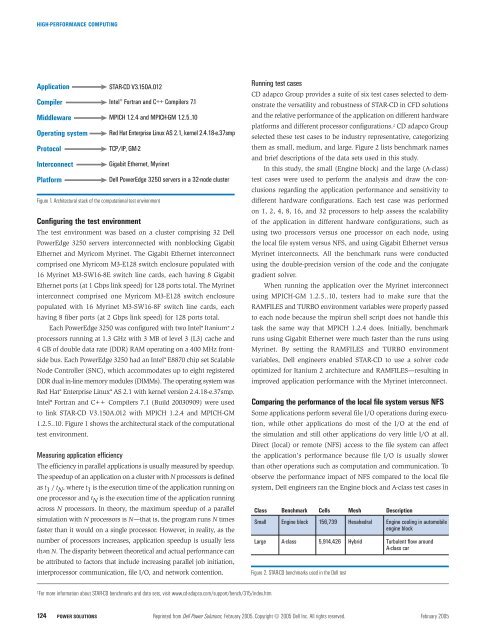Dell Power Solutions
Dell Power Solutions
Dell Power Solutions
- No tags were found...
You also want an ePaper? Increase the reach of your titles
YUMPU automatically turns print PDFs into web optimized ePapers that Google loves.
HIGH-PERFORMANCE COMPUTINGApplicationCompilerMiddlewareOperating systemProtocolInterconnectPlatformConfiguring the test environmentThe test environment was based on a cluster comprising 32 <strong>Dell</strong><strong>Power</strong>Edge 3250 servers interconnected with nonblocking GigabitEthernet and Myricom Myrinet. The Gigabit Ethernet interconnectcomprised one Myricom M3-E128 switch enclosure populated with16 Myrinet M3-SW16-8E switch line cards, each having 8 GigabitEthernet ports (at 1 Gbps link speed) for 128 ports total. The Myrinetinterconnect comprised one Myricom M3-E128 switch enclosurepopulated with 16 Myrinet M3-SW16-8F switch line cards, eachhaving 8 fiber ports (at 2 Gbps link speed) for 128 ports total.Each <strong>Power</strong>Edge 3250 was configured with two Intel ®Itanium®2processors running at 1.3 GHz with 3 MB of level 3 (L3) cache and4 GB of double data rate (DDR) RAM operating on a 400 MHz frontsidebus. Each <strong>Power</strong>Edge 3250 had an Intel ®E8870 chip set ScalableNode Controller (SNC), which accommodates up to eight registeredDDR dual in-line memory modules (DIMMs). The operating system wasRed Hat ®Enterprise Linux®AS 2.1 with kernel version 2.4.18-e.37smp.Intel ®Fortran and C++ Compilers 7.1 (Build 20030909) were usedto link STAR-CD V3.150A.012 with MPICH 1.2.4 and MPICH-GM1.2.5..10. Figure 1 shows the architectural stack of the computationaltest environment.Measuring application efficiencyThe efficiency in parallel applications is usually measured by speedup.The speedup of an application on a cluster with N processors is definedas t 1 / t N, where t 1 is the execution time of the application running onone processor and t N is the execution time of the application runningacross N processors. In theory, the maximum speedup of a parallelsimulation with N processors isSTAR-CD V3.150A.012Intel Fortran and C++ Compilers 7.1MPICH 1.2.4 and MPICH-GM 1.2.5..10Red Hat Enterprise Linux AS 2.1, kernel 2.4.18-e.37smpTCP/IP, GM-2Gigabit Ethernet, MyrinetFigure 1. Architectural stack of the computational test environment<strong>Dell</strong> <strong>Power</strong>Edge 3250 servers in a 32-node clusterN—that is, the program runsN timesfaster than it would on a single processor. However, in reality, as thenumber of processors increases, application speedup is usually lessthan N. The disparity between theoretical and actual performance canbe attributed to factors that include increasing parallel job initiation,interprocessor communication, file I/O, and network contention.Running test casesCD adapco Group provides a suite of six test cases selected to demonstratethe versatility and robustness of STAR-CD in CFD solutionsand the relative performance of the application on different hardwareplatforms and different processor configurations. 2 CD adapco Groupselected these test cases to be industry representative, categorizingthem as small, medium, and large. Figure 2 lists benchmark namesand brief descriptions of the data sets used in this study.In this study, the small (Engine block) and the large (A-class)test cases were used to perform the analysis and draw the conclusionsregarding the application performance and sensitivity todifferent hardware configurations. Each test case was performedon 1, 2, 4, 8, 16, and 32 processors to help assess the scalabilityof the application in different hardware configurations, such asusing two processors versus one processor on each node, usingthe local file system versus NFS, and using Gigabit Ethernet versusMyrinet interconnects. All the benchmark runs were conductedusing the double-precision version of the code and the conjugategradient solver.When running the application over the Myrinet interconnectusing MPICH-GM 1.2.5..10, testers had to make sure that theRAMFILES and TURBO environment variables were properly passedto each node because the mpirun shell script does not handle thistask the same way that MPICH 1.2.4 does. Initially, benchmarkruns using Gigabit Ethernet were much faster than the runs usingMyrinet. By setting the RAMFILES and TURBO environmentvariables, <strong>Dell</strong> engineers enabled STAR-CD to use a solver codeoptimized for Itanium 2 architecture and RAMFILES—resulting inimproved application performance with the Myrinet interconnect.Comparing the performance of the local file system versus NFSSome applications perform several file I/O operations during execution,while other applications do most of the I/O at the end ofthe simulation and still other applications do very little I/O at all.Direct (local) or remote (NFS) access to the file system can affectthe application’s performance because file I/O is usually slowerthan other operations such as computation and communication. Toobserve the performance impact of NFS compared to the local filesystem, <strong>Dell</strong> engineers ran the Engine block and A-class test cases inClass Benchmark Cells Mesh DescriptionSmall Engine block 156,739 Hexahedral Engine cooling in automobileengine blockLarge A-class 5,914,426 Hybrid Turbulent flow aroundA-class carFigure 2. STAR-CD benchmarks used in the <strong>Dell</strong> test2For more information about STAR-CD benchmarks and data sets, visit www.cd-adapco.com/support/bench/315/index.htm.124POWER SOLUTIONS Reprinted from <strong>Dell</strong> <strong>Power</strong> <strong>Solutions</strong>, February 2005. Copyright © 2005 <strong>Dell</strong> Inc. All rights reserved. February 2005








